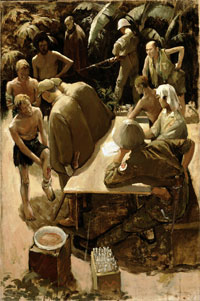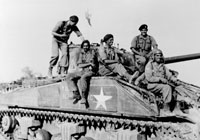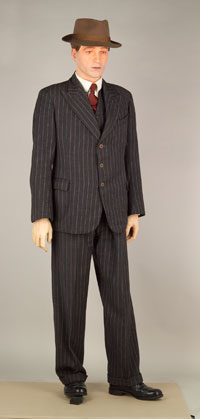

Telephone switchboard, Hitler's Headquarters, Wolfschanze, East Prussia

The Lair of the Wolf
Adolf Hitler's Supreme Command Headquarters, nicknamed the ‘Wolf’s Lair’, was located in woodland near Rastenburg in East Prussia (now Poland). It consisted of a complex of bunkers fortified by barbed wire and minefields. Built in 1941 for the German invasion of the Soviet Union, it was abandoned in 1944 when Russian troops approached East Prussia. The names on the telephone switchboard include the head of the Schutzstaffel (SS) Heinrich Himmler, Hermann Goering the chief of the German Airforce, Sepp Dietrich who commanded Hitler’s bodyguard, Wilhelm Keitel the Commander-in-Chief of the High Command of the Armed Forces (OKW), Alfred Jodl, Chief of Staff of the Wehrmact, and Martin Borman, the head of the Nazi Party Chancellery and Hitler’s Secretary. All of these men were indicted war criminals and wanted by the Allies for crimes against humanity. The telephone exchange is a fitting symbol of the Allied victory in what was a fight to the finish against a tyranny that launched the deadliest war in human history.
Section of sleeper from the Thai-Burma Railway

Railway of death
Between October 1942 and December 1943 the Japanese Army used forced labour to build a 420km railway through mountainous jungle to link Burma (now Myanmar) and Siam (now Thailand). The project was designed to safeguard the passage of supplies from Singapore and Bangkok to the Japanese armies fighting in Burma. It led to the deaths of around 15,000 Allied prisoners of war and over 80,000 Asian civilians from over-work, disease and starvation. The Japanese used the railway until November 1944, when parts of the line and the famous bridge over the River Kwai were destroyed in Allied air raids. This 14 inch long section of wood is from one of the rail sleepers at Thanbyuzayat at the Burmese end of the line. It is housed in a red and gold coloured wood box and was used as a miniature Buddhist shrine, a fitting act of remembrance for the railway’s thousands of victims.
Photograph: Indian Army tank crew on top of their Sherman

NAM 1974-09-79-71
Largest volunteer army in history
The Indian Army made a vital contribution to the British Empire’s war effort during the two world wars. During World War One, over one million Indian troops served overseas, at Gallipoli, in the Middle East, East Africa and on the Western Front. During World War Two the Indian Army expanded to a maximum strength of over two million troops, the largest volunteer army in history. During the war, Indian troops served in North Africa, the Middle East, Italy and the Far East. In 1947 this volunteer Army formed the basis of the armies of the newly independent nations of India and Pakistan.
Photograph: Allied prisoner of war liberated from a Japanese POW camp

NAM 1991-01-24-1
Behind the wire
Around 13,000 British POWs died in Japanese captivity during World War Two, the victims of malnutrition, disease and violence. Many of these men had become POWs when Singapore was taken in February 1942 and were to spend the next three and a half years in captivity.
The men were used as forced labourers on Japanese military projects in Japan, in the Malay peninsular and on the construction of the Thai-Burma railway linking Bangkok and Rangoon.
The Japanese treated these men inhumanely because they believed that surrender was dishonourable and that it was a soldier's duty to commit suicide if captured.
Demobilization suit

NAM 1980-12-28
A democratic fashion
Limited as it was in colour, size and style, the demobilization or ‘demob’ suit was the subject of many jokes. Nevertheless, it remains a suitably democratic symbol of the ‘People’s War’ of 1939-1945.
The demobilization of the Army started on 16 June 1945, six weeks after the German surrender. Soldiers were released according to age and length of service. Each man was given a choice of suit, and issued with a raincoat, a shirt with two collars, a hat, a tie, shoes and two pairs of socks.
Women received a cash grant and clothing coupons. Discharged service personnel also received three weeks pay and 56 days leave. Between December 1945 and December 1946 2,773,357 men and 176,929 women were demobilized.

